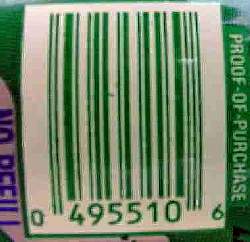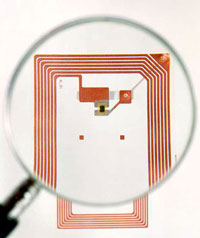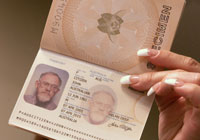Introduction to How RFID Works
Long checkout lines at the grocery store are one of the biggest complaints about the shopping experience. Soon, these lines could disappear when the ubiquitous Universal Product Code (UPC) bar code is replaced by smart labels, also called radio frequency identification (RFID) tags. RFID tags are intelligent bar codes that can talk to a networked system to track every product that you put in your shopping cart.
Imagine going to the grocery store, filling up your cart and walking right out the door. No longer will you have to wait as someone rings up each item in your cart one at a time. Instead, these RFID tags will communicate with an electronic reader that will detect every item in the cart and ring each up almost instantly. The reader will be connected to a large network that will send information on your products to the retailer and product manufacturers. Your bank will then be notified and the amount of the bill will be deducted from your account. No lines, no waiting.
RFID tags, a technology once limited to tracking cattle, are tracking consumer products worldwide. Many manufacturers use the tags to track the location of each product they make from the time it's made until it's pulled off the shelf and tossed in a shopping cart.
Outside the realm of retail merchandise, RFID tags are tracking vehicles, airline passengers, Alzheimer's patients and pets. Soon, they may even track your preference for chunky or creamy peanut butter. Some critics say RFID technology is becoming too much a part of our lives -- that is, if we're even aware of all the parts of our lives that it affects.
In this article, you'll learn about the types of RFID tags and how these tags can be tracked through the entire supply chain. We'll also look at the non-commercial uses of RFID tags and how the Departments of State and Homeland Security are using them.
Reinventing the Bar Code
Almost everything that you buy from retailers has a UPC bar code printed on it. These bar codes help manufacturers and retailers keep track of inventory. They also give valuable information about the quantity of products being bought and, to some extent, by whom the products are being bought. These codes serve as product fingerprints made of machine-readable parallel bars that store binary code.

Barcodes, like this one found on a soda can, are found on almost everything we buy.
|
Created in the early 1970s to speed up the check out process, bar codes have a few disadvantages:
- In order to keep up with inventories, companies must scan each bar code on every box of a particular product.
- Going through the checkout line involves the same process of scanning each bar code on each item.
- Bar code is a read-only technology, meaning that it cannot send out any information.
RFID tags are an improvement over bar codes because the tags have read and write capabilities. Data stored on RFID tags can be changed, updated and locked. Some stores that have begun using RFID tags have found that the technology offers a better way to track merchandise for stocking and marketing purposes. Through RFID tags, stores can see how quickly the products leave the shelves and who's buying them.
In addition to retail merchandise, RFID tags have also been added to transportation devices like highway toll passcards and subway passes. Because of their ability to store data so efficiently, RFID tags can tabulate the cost of tolls and fares and deduct the cost electronically from the amount of money that the user places on the card. Rather than waiting to pay a toll at a tollbooth or shelling out coins at a token counter, passengers use RFID chip-embedded passes like debit cards.
But would you entrust your medical history to an RFID tag? How about your home address or your baby's safety? Let's look at two types of RFID tags and how they store and transmit data before we move past grocery store purchases to human lives.
Bar Code History
At 8:01 a.m. on June 26, 1974, a customer at Marsh's supermarket in Troy, OH, made the first purchase of a product with a barcode, a 10-pack of Wrigley's Juicy Fruit Gum. This began a new era in retail that sped up checkout lines and gave companies a more efficient method for inventory control. That pack of gum took its place in American history and is currently on display at the Smithsonian Institution's National Museum of American History. That historical purchase was the culmination of nearly 30 years of research and development. The first system for automatic product coding was patented by Bernard Silver and Norman Woodland, both graduate students at the Drexel Institute of Technology (now Drexel University). They used a pattern of ink that glowed under ultraviolet light. This system was too expensive and the ink wasn't very stable. The system we use today was unveiled by IBM in 1973 and uses readers designed by NCR. |
RFID Tags Past and Present
RFID technology has been around since 1970, but until recently, it has been too expensive to use on a large scale. Originally, RFID tags were used to track large items, like cows, railroad cars and airline luggage, that were shipped over long distances, These original tags, called inductively coupled RFID tags, were complex systems of metal coils, antennae and glass.
Inductively coupled RFID tags were powered by a magnetic field generated by the RFID reader. Electrical current has an electrical component and a magnetic component -- it is electromagnetic. Because of this, you can create a magnetic field with electricity, and you can create electrical current with a magnetic field. The name "inductively coupled" comes from this process -- the magnetic field inducts a current in the wire.

Photo courtesy Getty Images
This RFID tag from Texas Instruments dates back to 1999, when it was used to track luggage.
|
Capacitively coupled tags were created next in an attempt to lower the technology's cost. These were meant to be disposable tags that could be applied to less expensive merchandise and made as universal as bar codes. Capacitively coupled tags used conductive carbon ink instead of metal coils to transmit data. The ink was printed on paper labels and scanned by readers.
Motorola's BiStatix RFID tags were the frontrunners in this technology. They used a silicon chip that was only 3mm wide and stored 96 bits of information. This technology didn't catch on with retailers, and BiStatix was shut down in 2001 [source:
RFID Journal].
Newer innovations in the RFID industry include active, semi-active, and passive RFID tags. These tags can store up to 2 kilobytes of data and are composed of a microchip, antenna, and, in the case of active and semi-passive tags, a battery. The tag's components are enclosed within plastic, silicon or sometimes glass.
At a basic level, each tag works in the same way:
- Data stored within an RFID tag's microchip waits to be read.
- The tag's antenna receives electromagnetic energy from an RFID reader's antenna.
- Using power from its internal battery or power harvested from the reader's electromagnetic field, the tag sends radio waves back to the reader.
- The reader picks up the tag's radio waves and interprets the frequencies as meaningful data.
Inductively coupled and capacitively coupled RFID tags aren't used as commonly today because they are expensive and bulky. In the next section, we'll learn more about active, semi-passive and passive RFID tags.
Active, Semi-passive and Passive RFID Tags
Active, semi-passive and passive RFID tags are making RFID technology more accessible and prominent in our world. These tags are less expensive to produce, and they can be made small enough to fit on almost any product.
Active and semi-passive RFID tags use internal batteries to power their circuits. An active tag also uses its battery to broadcast radio waves to a reader, whereas a semi-passive tag relies on the reader to supply its power for broadcasting. Because these tags contain more hardware than passive RFID tags, they are more expensive. Active and semi-passive tags are reserved for costly items that are read over greater distances -- they broadcast high frequencies from 850 to 950 MHz that can be read 100 feet or more away. If it is necessary to read the tags from even farther away, additional batteries can boost a tag's range to over 300 feet (100 meters) [source: RFID Journal].
Passive RFID tags rely entirely on the reader as their power source. These tags are read up to 20 feet away, and they have lower production costs, meaning that they can be applied to less expensive merchandise. These tags are manufactured to be disposable, along with the disposable consumer goods on which they are placed. Whereas a railway car would have an active RFID tag, a bottle of shampoo would have a passive tag.
Another factor that influences the cost of RFID tags is data storage. There are three storage types: read-write, read-only and WORM (write once, read many). A read-write tag's data can be added to or overwritten. Read-only tags cannot be added to or overwritten -- they contain only the data that is stored in them when they were made. WORM tags can have additional data (like another serial number) added once, but they cannot be overwritten.

Photo courtesy Getty Images
This tiny RFID tag will be placed on a bottle of moisturizer.
|
Most passive RFID tags cost between 7 and 20 cents each [source:
RFID Journal]. Active and semi-passive tags are more expensive, and RFID manufacturers typically do not quote prices for these tags without first determining their range, storage type and quantity. The RFID industry's goal is to get the cost of a passive RFID tag down to 5 cents each once more merchandisers adopt it.
In the next section, we'll learn how this technology could be used to create a global system of RFID tags that link to the Internet.
Talking Tags
When the RFID industry is able to lower the price of tags, it will lead to a ubiquitous network of smart packages that track every phase of the supply chain. Store shelves will be full of smart-labeled products that can be tracked from purchase to trash can. The shelves themselves will communicate wirelessly with the network. The tags will be just one component of this large product-tracking network.
The other two pieces to this network will be the
readers that communicate with the tags and the
Internet, which will provide communications lines for the network.
Let's look at a real-world scenario of this system:
- At the grocery store, you buy a carton of milk. The milk containers will have an RFID tag that stores the milk's expiration date and price. When you lift the milk from the shelf, the shelf may display the milk's specific expiration date, or the information could be wirelessly sent to your personal digital assistant or cell phone.
- As you exit the store, you pass through doors with an embedded tag reader. This reader tabulates the cost of all the items in your shopping cart and sends the grocery bill to your bank, which deducts the amount from your account. Product manufacturers know that you've bought their product, and the store's computers know exactly how many of each product need to be reordered.
- Once you get home, you put your milk in the refrigerator, which is also equipped with a tag reader. This smart refrigerator is capable of tracking all of the groceries stored in it. It can track the foods you use, how often you restock your refrigerator and can let you know when that milk and other foods spoil.
- Products are also tracked when they are thrown into a trash can or recycle bin. At this point, your refrigerator could add milk to your grocery list, or you could program the fridge to order these items automatically.
- Based on the products you buy, your grocery store gets to know your unique preferences. Instead of receiving generic newsletters with weekly grocery specials, you might receive one created just for you. If you have two school-age children and a puppy, your grocery store can use customer-specific marketing by sending you coupons for items like juice boxes and dog food.
In order for this system to work, each product will be given a unique product number. MIT's Auto-ID Center is working on an Electronic Product Code (EPC) identifier that could replace the UPC. Every smart label could contain 96 bits of information, including the product manufacturer, product name and a 40-bit serial number. Using this system, a smart label would communicate with a network called the Object Naming Service. This database would retrieve information about a product and then direct information to the manufacturer's computers.
The information stored on the smart labels would be written in a Product Markup Language (PML), which is based on the eXtensible Markup Language (XML). PML would allow all computers to communicate with any computer system similar to the way that Web servers read Hyper Text Markup Language (HTML), the common language used to create Web pages.
We're not at this point yet, but RFID tags are more prominent in your life than you may realize. Wal-Mart and Best Buy are just two major merchandisers that use RFID tags for stocking and marketing purposes.
Some critics find the idea of merchandisers tracking and recording purchases to be alarming. But retail isn't the only industry using RFID technology. In the next section, we'll learn how the government is putting RFID tags to use.
Government-issued RFIDs
While many consumers happily -- or obliviously -- buy merchandise tracked with RFID tags, some people are up in arms about the federal government's legislation mandating that passports be embedded with RFID microchips.
On Aug. 14, 2006, the Department of State began issuing electronic passports, or e-passports. Prompted by the terrorist attacks of Sept.11, 2001 the Department of Homeland Security (DHS) proposed the e-passport as a security measure for air travel safety, border security and more efficient customs procedures at airports. The e-passport's enhanced security features -- a chip identification number, digital signature and photograph that acts as a biometric identifier - make the passport impossible to forge.
The e-passport will help improve security, but with so much personal information embedded in the document, there have been many concerns raised about the e-passport's potential for identity theft. Two possible forms of identity theft that could occur with e-passports are:
- Skimming happens when someone uses an RFID reader to scan data from an RFID chip without the e-passport holder's knowledge.
- Eavesdropping happens when someone reads the frequencies emitted from the RFID chip as it is scanned by an official reader.
However, the DHS insists that the e-passport is perfectly safe to use and that proper precautions have been taken to ensure user confidentiality.
- For protection against skimming, the e-passport contains a metallic anti-skimming device. This device is a radio shield inserted between the passport's cover and first page. When the e-passport is closed, it can't be scanned at all; when it's open, it can only be read by a scanner that is less than 10 centimeters away [source: Department of State].
- To guard against eavesdropping, DHS has mandated that all areas where the e-passport is scanned be thoroughly covered and enclosed so that signals cannot be picked up beyond the authorized RFID reader.

Photo courtesy Getty Images
The Australian passport served as a model for the new United States e-passport.
|
The e-passport costs $97. While the cost to you may seem steep, the cost of installing RFID readers in airports is even more staggering. Adopting the e-passport will require gradual change, but authorities are already discussing what added security features and improved biometrics the next series of e-passports will have.
The debate over e-passports pales in comparison to debates over human chipping. Next, we'll learn what RFID microchips are doing in living things.
REAL ID
From air traffic to road traffic, security is becoming a more pressing issue, and some people feel that they're being monitored more closely than ever before. REAL ID, a program developed by the 9/11 Commission, is intended to improve the way that official identification is issued. While the REAL ID has yet to be approved (and is being heatedly debated), the first proposed REAL ID is the REAL ID driver's license. DHS issued a Notice of Proposed Rulemaking for the REAL ID driver's license on March 1, 2007. The REAL ID driver's license can be enhanced to give you easy border-crossing access to Canada, and beyond a standard driver's license, it also grants you access to federal facilities, federal aircraft and nuclear power plants [source: Department of Homeland Security]. States will choose whether or not to embed RFID chips in the REAL ID driver's license in place of the current 2-D bar code. |
For lots more information about RFID technology, check out the links:
- Albrecht, Katherine and Liz McIntyre. "Spychips: How Major Corporations and Government Plan to Track Your Every Move with RFID." Chapter One. LFB.com. 2005 (10/17/2007).
http://www.lfb.com/index.php?stocknumber=PV9017
- C.A.S.P.I.A.N. Consumers Against Supermarket Privacy Invasion and Numbering. (10/17/2007).
http://www.nocards.org/
- "Chipped Passports Coming Monday." WIRED. 8/11/2006 (10/16/2007).
http://www.wired.com/print.techbiz/media/news/2006/08/71583
- Collins, Jonathan. "RFID Labels for Less." RFID Journal. 1/26/2004 (10/17/2007).
http://www.rfidjournal.com/article/articleprint/770/-1/1/
- Department of Homeland Security. "E-Passports." (10/16/2007)
http://www.dhs.gov/xtrvlsec/crossingborders/gc_1161636133959.shtm
- Department of Homeland Security. "REAL ID." (10/17/2007).
http://www.dhs.gov/xprevprot/laws/gc_1172767635686.shtm
- Department of State. "Department of State Begins Issuing Electronic Passports to the Public." Office of the Spokesman. 8/14/2006 (10/16/2007).
http://www.state.gov/r/pa/prs/ps/2006/70433.htm
- Digital Angel Corporation. (10/17/2007).
http://www.digitalangelcorp.com/da/default.aspx
- Ferguson, Renee Boucher. "Symbol's Future with RFID Uncertain Under Motorola Umbrella." eWeek.com 9/21/2006 (10/17/2007).
http://www.eweek.com/article2/0,1895, 2019097,00.asp
- Heim, Kristi. "Privacy concerns attached to RFID tags." Seattle Times. 7/19/2007. (10/16/2007).
http://seattletimes.nwsource.com/cgibin/PrintStory.pl?document_id=2003795541&zsection_id=2002119995&slug=rfid19&date=20070719
- Hook, Brian R. "RFID Tags: Preventing or Promoting Identity Theft?" CRMBuyer. 7/5/2007 (10/16/2007).
http://www.crmbuyer.com/story/44320.html
- Lewan, Todd. "Chips: High-tech aids or tracking devices?" MSNBC.com. 8/23/2007 (10/16/2007).
http://www.msnbc.msn.com/id/19904543/print1/displaymode/1098
- Lewan, Todd. "Chip Implants Linked to Animal Tumors." WashingtonPost.com. 9/8/2007 (10/17/2007).
http://www.washingtonpost.com/wpdyn/content/article/2007/09/08/AR2007090800997_pf.html
- Lettice, John. "First people injected with ID chips, sales drive kicks off." 6/10/2002 (10/16/2007).
http://www.theregister.co.uk/2002/06/10/first_people_injectedwith_id/print.html
- Mott, Maryann. "Pet Microchip IDs Need Standardization Tech, U.S. Government Says." National Geographic News. 11/15/2005 (10/22/2007).
http:://news.nationalgeographic.com/news/2005/11/1115_051115_pets_chips.html
- O'Connor, Mary Catherine. "U.S. Bill Include RFID Provision for Pets." RFID Journal. 11/10/2005 (10/22/2007).
http://www.rfidjournal.com/article/articleprint/1976/-1/1
- RFID Journal. (10/17/2007)
http://www.rfidjournal.com
- Scheeres, Julia. "ID Chip's Controversial Approval." WIRED. 10/23/02 (10/16/2007).
http://www.wired.com/print/politics/law/news/2002/10/55952.
- Sieberg, Daniel. "Is RFID tracking you?" CNN.com. 10/23/2006 (10/17/2007).
http://www.cnn.com/2006/TECH/07/10/rfid/index.html
- Sullivan, Laurie. "RFID System Prevented a Possible Infant Abduction." InformationWeek. 7/19/2007. (10/17/2007).
http://www.informationweek.com/ story/showArticle.jhtml?articleID=166400496
- Swedburg, Claire. "Researchers Use RFID to Fight SIDS." RFID Journal. 4/17/2007 (10/17/2007).
http://www.verichipcorp.com/news/1121749200
- West, Karen. "Vegas bets on radio chips for luggage problems." MSNBC. 10/13/2006 (10/17/2007).
http://www.msnbc.msn.com/id/15235999
- "What the Motorola-Symbol Deal Means for RFID." RFID Update. 9/20/2006 (10/16/2007).
http://www.rfidupdate.com/articles/index.php?id=1207
- Witteman, Marc. "Is e-passport security effective yet?" Keesing Journal of Documents and Identity. 2007 (10/16/2007).
http://www.riscure.com/1_general/articles/KJD23_Witteman.pdf
- Yu, Roger, Danielle Belopotosky, Dan Caterinicchia, and Dibya Sarker. "E-Passport."
Source:howstuffworks.com


 Articles
Articles  RFID Technology
RFID Technology  How RFID Works
How RFID Works

